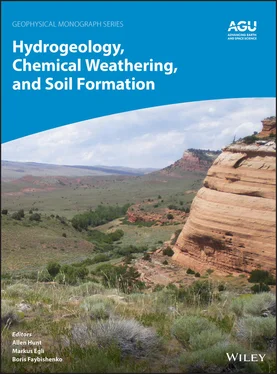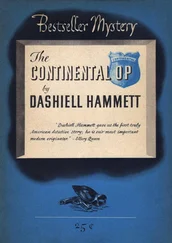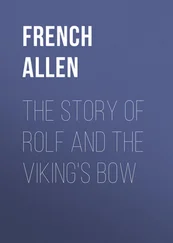
which states that soil, S , is formed from parent material, M , by the work of climatic factors, C , and vegetation, V , over a time, T , but the process may be modified by erosion of, or deposition upon, the soil surface, D . Shaw noted that each of the factors in soil formation is important in determining the character of soil, though under local conditions any one factor may exert a dominant influence.
1.2.3. Jenny’s CLORPT Equation
The most famous and lasting development of Dokuchaev’s approach was the CLORPT equation given by Hans Jenny (1941). This equation expresses any soil or soil property, s , as a function of soil‐forming factors:

where cl is environmental climate; o is organisms (the fauna and flora originally in the system and that entering later); r is topography, including hydrological features such as the water table; p is parent material, defined as the initial state of soil when pedogenesis starts; t is the age of the soil, or absolute period of soil formation; and the dots are additional factors such as fire. In short, the state of the soil or specific soil properties is a function of the external environment.
It is clear that this CLORPT equation is the same as Zakharov’s equation but with the soil‐forming factors appearing in a different order. For this reason, and given the earlier date of Zakharov’s formulation, Igor V. Florinski (2011, 2012) suggested it should be called the Zakharov–Jenny equation. However, Jenny “framed and expanded the existing theory and lifted it to a level that is the accepted to the present day,” which explains his influence (Hartemink, 2016, 88).
Several researchers proposed modifications of Jenny’s original formula. Sergius A. Wilde (1946, 13) recast Dokuchaev’s formula so that time was expressed as a differential:

where s is soil, g is geological (parent) material, e is environmental influences, and b is biological activity. This model was further modified by Charles G. Stephens (1947) who split environmental influences into climate, c , relief, r , and water table, w , and changed the g and b factors into parent material, p , and organisms, o :

which is almost identical to the CLORPT equation except time is seen to influence all factors and the factors can have dependent and independent status.
Jack Major (1951) extended the CLORPT equation to embrace the entire ecosystem: soils, vegetation, and animal life. Jenny (1961a, 1980) offered his own extension that included ecosystems (entire sections of landscapes). He derived a general state‐factor equation of the form

where l is ecosystem properties such as total carbon content, primary production, and respiration; v is vegetation properties such as biomass, species frequency, and sodium content; a is animal properties such as size, growth rate, and color; s is soil properties such as pH, texture, humus content; L 0is the initial state of the system, that is, the assemblage of properties at time zero when development starts (the L stands for the ecosystem, or larger system as Jenny styled it, of which the soil is part); P xare external flux potentials; and t is the age of the system.
The state factors are groups of variables associated with L 0and P x. The initial state of the system is defined by parent material, p , and by the original topography and water table, r . The external flux potentials are environmental properties that lead to additions and subtractions of matter and energy to and from the system. They include environmental climate, cl , a biotic factor, o , comprising fauna and flora as a pool of species or genes, active or dormant, that happen to be in the ecosystem at time zero or that enter it later. The biotic factor is thus distinct from the vegetation that grows as the system develops; this appears as a system property on the left‐hand side of the equation. Other external fluxes would include dust storms, floods, and the additions of fertilizers; these could be given symbols and entered separately in the equation if so desired. In an extended form, the general state‐factor equation becomes

That brings us back to the CLORPT equation, only this time it applies to ecosystems and not just soils. An even later version of the CLORPT equation considered the place of the human species in the state‐factor theory of ecosystems (Amundson & Jenny, 1991).
Henry Lin (2011) pointed out that climate, organisms, relief, and parent material vary across geographical space and all change with time, which in turn means that soil environments change continuously through time, a point stressed by Dokuchaev and others (e.g. Johnson et al., 1990). To address this problem, Lin suggested an equation for the total change of a soil profile over a pedogenic time period t = t n– t 0(where t nis the current time and t 0is the beginning of pedogenesis) to capture the cumulative effects of all four time‐dependent spatial factors on pedogenesis:

Grouping the spatial soil‐forming factors into flux factors ( cl and o ) and site factors ( p and r ), Lin writes this equation more succinctly as:

which specifies the cumulative effects of climate and organisms on pedogenesis conditioned by parent material and topography.
Jenny’s formulation has proved itself exceedingly valuable, both as a conceptual and a research tool. It has deepened understanding of soil variation across individual state factors (see below), although attempts to tackle the combined effects of all state factors using multivariate techniques have had little success (Yaalon, 1975; Amundson & Jenny, 1997). Nevertheless, the CLORPT equation is still cited and used, albeit in slightly modified forms, by pedologists and, to a lesser degree, ecologists. And it has acted as a springboard for later concepts regarding the soil as a system, a development instigated by Jenny himself.
Читать дальше




















